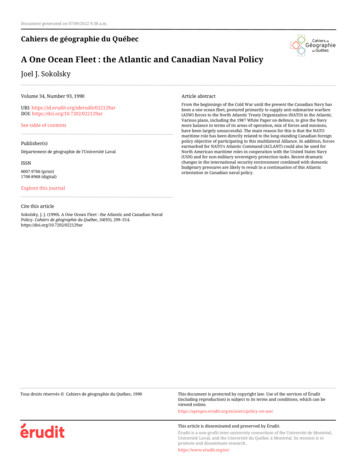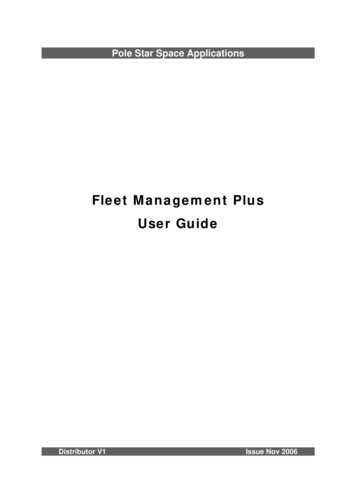
Transcription
Document generated on 07/09/2022 9:38 a.m.Cahiers de géographie du QuébecA One Ocean Fleet : the Atlantic and Canadian Naval PolicyJoel J. SokolskyVolume 34, Number 93, 1990URI: https://id.erudit.org/iderudit/022129arDOI: https://doi.org/10.7202/022129arSee table of contentsPublisher(s)Département de géographie de l'Université LavalISSN0007-9766 (print)1708-8968 (digital)Article abstractFrom the beginnings of the Cold War until the present the Canadian Navy hasbeen a one ocean fleet, postured primarily to supply anti-submarine warfare(ASW) forces to the North Atlantic Treaty Organization (NATO) in the Atlantic.Various plans, including the 1987 White Paper on defence, to give the Navymore balance in terms of its areas of operation, mix of forces and missions,have been largely unsuccessful. The main reason for this is that the NATOmaritime role has been directly related to the long-standing Canadian foreignpolicy objective of participating in this multilateral Alliance. In addition, forcesearmarked for NATO's Atlantic Command (ACLANT) could also be used forNorth American maritime roles in cooperation with the United States Navy(USN) and for non-military sovereignty protection tasks. Recent dramaticchanges in the international security environment combined with domesticbudgetary pressures are likely to result in a continuation of this Atlanticorientation in Canadian naval policy.Explore this journalCite this articleSokolsky, J. J. (1990). A One Ocean Fleet : the Atlantic and Canadian NavalPolicy. Cahiers de géographie du Québec, 34(93), 299–314.https://doi.org/10.7202/022129arTous droits réservés Cahiers de géographie du Québec, 1990This document is protected by copyright law. Use of the services of Érudit(including reproduction) is subject to its terms and conditions, which can beviewed on-use/This article is disseminated and preserved by Érudit.Érudit is a non-profit inter-university consortium of the Université de Montréal,Université Laval, and the Université du Québec à Montréal. Its mission is topromote and disseminate research.https://www.erudit.org/en/
CAHIERS DE GÉOGRAPHIE DU QUÉBECVol. 34, no 93, décembre 1990, 299-314A ONE OCEAN FLEET:THE ATLANTIC AND CANADIAN NAVAL POLICYbyJoël J. SOKOLSKYDepartment of Political and Economie Science,The Royal Military Collège of Canada,Kingston (Ontario), K7K 5L0ABSTRACTFrom the beginnings of the Cold War until the présent the Canadian Navy has been a one océanfleet, postured primarily to supply anti-submarine warfare (ASW) forces to the North Atlantic TreatyOrganization (NATO) in the Atlantic. Various plans, including the 1987 White Paper on defence, to givethe Navy more balance in terms of its areas of opération, mix of forces and missions, hâve been largelyunsuccessful. The main reason for this is that the NATO maritime rôle has been directly related to thelong-standing Canadian foreign policy objective of participating in this multilatéral Alliance. In addition,forces earmarked for NATO's Atlantic Command (ACLANT) could also be used for North Americanmaritime rôles in coopération with the United States Navy (USN) and for non-military sovereigntyprotection tasks. Récent dramatic changes in the international security environment combined withdomestic budgetary pressures are likely to resuit in a continuation of this Atlantic orientation inCanadian naval policy.KEY WORDS: Canadian Navy, NATO, collective defence.RÉSUMÉUne flotte confinée à un seul océan: la politique navale canadienne dans l'AtlantiqueDepuis le début de la guerre froide jusqu'à nos jours, la marine canadienne constitue une flotteconfinée à un océan, se consacrant avant tout à la guerre anti-sous-marine au service de l'Organisationdu traité de l'Atlantique Nord (OTAN) dans l'océan Atlantique. Divers plans, incluant le Livre blanc sur ladéfense de 1987, visant à rétablir l'équilibre au niveau des aires d'opération de la marine canadienneainsi qu'au niveau de la puissance navale et de ses différentes missions, ont été jusqu'à dateinfructueux. La principale raison de cette situation est que le rôle maritime de l'OTAN a été directementrelié à l'objectif de la politique étrangère canadienne, en vigueur depuis longtemps, consistant à uneparticipation active dans cette alliance multilatérale. De plus les forces affectées au Commandementallié de l'Atlantique de l'OTAN (ACLANT) pouvaient aussi être utilisées pour des rôles maritimes nordaméricains en coopération avec la marine américaine ainsi que pour des tâches non militaires reliées àla protection de la souveraineté. De récents changements dramatiques au niveau de la sécuritéinternationale combinés à des restrictions budgétaires domestiques vont probablement faire en sorteque l'orientation atlantique de la politique navale canadienne va se poursuivre.MOTS-CLÉS: Marine canadienne, OTAN, défense collective.
300CAHIERS DE GEOGRAPHIE DU QUEBEC, Vol. 34, no 93, décembre 1990Table 1Relevant LBMSLCMSLOCSOSUSSSBSSBNSSNSTARTUSAFUSNNorth Atlantic Treaty Organization's Atlantic CommandAustralia-New Zealand-United States Treaty AllianceAnti-Submarine WarfareCanadian Atlantic AreaFleet Opérations Control Centre of the Commander-in-Chief, United StatesAtlantic FleetDéfense Structure ReviewGeneral Purpose FrigateIntercontinental Ballistic MissileLong Range Maritime Patrol AircraftMaritime CommandNorth Atlantic Océan Régional Planning GroupNorth Atlantic Treaty OrganizationNorth American Air Defence CommandRoyal Canadian Air ForceRoyal Canadian NavyRoyal NavyStratégie Air CommandSuprême CommanderHouse of Commons Standing Committee on Extemal Affairs and NationalDéfenseSubmarine Launched Ballistic MissileSubmarine Launched Cruise MissileSea Lines of CommunicationSound Surveillance SystemConventionally Powered Ballistic Missile SubmarinesNuclear Powered Ballistic Missile SubmarineNuclear Powered Attack SubmarinesStratégie Arms Réduction TalksUnited States Air ForceUnited States' NavyINTRODUCTIONThe key élément of the defence policy announced in the June 1987 Canadian WhitePaper (Canada, 1987) was the création of a "modem and effective","well balanced", "threeocéan" Navy.The Minister of National Defence told the House of Commons that the Navy was "onthe verge of rust out". Its youngest ship was being built at the time of the previous WhitePaper in 1971, and the oldest was commissioned in the 1950s. A three océan navy wasnecessary, the government argued, because Canada now had growing maritime securityinterests in the Pacific and the Arctic, as well as in the Atlantic where it had heretoforeconcentrated its naval efforts. To operate more effectively in ail three océans, the WhitePaper proposed to balance the fleet by adding to its traditional surface and air antisubmarine (ASW) forces ten to twelve nuclear-powered attack submarines (SSN).This new, modem, effective three océan fleet was not to be. In April 1989, the Mulroneygovernment cancelled the SSN program and severely eut the defence budget, ail but
THE ATLANTIC AND CANADIAN NAVAL POLICY301repudiating the White Paper. But the intense, albeit brief, debate it touched off about therôles and missions of the Navy drew attention to the overwhelmingly Atlantic orientation ofCanadian naval policy. Despite the fact that Canada is a trading nation bordered bythree océans with the longest coastline in the world, it is security and political considérationsin the Atlantic which hâve almost exclusively determined the maritime forces Canada hasmaintained.This paper examines the impact of the Atlantic orientation on the Canadian Navy in thepost 1945 period. It argues that it was stratégie and especially political considérationsrelating to security in Europe as expressed in Canada's participation in NATO (North AtlanticTreaty Organization), as opposed to exclusive Canadian maritime interests, or even NorthAmerican defence, which determined the Navy's posture in the Cold War and beyond. Animportant reason why this was acceptable was that the NATO-oriented Navy meshed wellwith continental and national rôles in the Atlantic. In part, this explains why the ambitiousnaval building program of the White Paper floundered and ultimately went under. To be sure,a contributing factor was récent dramatic changes in East-West relations. Indeed the paperconcludes that precisely because the Navy has known no other orientation than Atlanticism,thèse récent trends are so germane to the very future of Canada's maritime forces.CANADA AND THE NATO MARITIME ALLIANCEThe govemment and other supporters of the White Paper's naval building, stressedCanada's many maritime interests. In addition to having the longest coastline in the world,the new Law of the Sea's 200 mile Exclusive Economie Zone will bring vast océan areasunder Canada's jurisdiction with fishing areas extending even further. Ottawa has alsoclaimed ail the internai waters of the Arctic archipelago, including the Northwest passage.As a trading nation Canada dépends heavily upon transoceanic shipping in the Atlantic andincreasingly in the Pacific.As extensive as its maritime interests hâve been, thèse interests cannot account for theposture of the Navy since 1945. The purpose of the Canadian Navy has not been to protectexclusive Canadian économie or sovereignty interests at sea. Rather it has been tocontribute to the maritime portion of the West's collective déterrent posture. This situation isnot unique to Canada. If seapower corresponded to national économie dependence uponthe océans, then both the United States and the Soviet Union would hâve much smallernavies and other states more dépendent on the seas would hâve larger ones. In reality, thenavies of the superpowers are based upon military considérations ranging from thedeployment of stratégie nuclear weapons at sea, to the need to secure or deny use of thesea to the opposing side in the event of a war in Europe, to traditional gunboat diplomacy inthe Third World. Even the modem naval building programs of such important shipping andtrading nations as the Scandinavian countries and the West European NATO allies, hâvebeen driven more from appréhensions about a Soviet threat, on land as well as sea, than asa resuit of exploitation of the seas, even for shipping. As John J. Clark observed in 1967, theneed for naval forces arises because of military considérations and "persists [.]independently of the flux of trade [.]. If merchant shipping were no longer to ply the sealanes, naval présence would still be considered necessary for the free world" (Clark, 1967,p. 164).At the end of the Second World War Canada had the third largest navy in the world. Asearly as 1943, the Naval Staff was planning for a postwar balanced fleet to encompass awide range of capabilities. But even though Canada's transoceanic trade and fishing
302CAHIERS DE GÉOGRAPHIE DU QUÉBEC, Vol. 34, no 93, décembre 1990industries expanded during the postwar économie boom, the Navy was drastically reducedas part of the massive demobilization that affected ail the forces during thèse years.In January 1947, the Government eut 50 million from the naval estimâtes and reducedmanpower ceiling to 7 500 and by 1948 the fleet numbered forty-four vessels including oneaircraft carrier, two cruisers, eighteen frigates and destroyers and nine minesweepers(Hobson, 1986, p. 15).In the past, Canada had relied upon the Royal Navy (RN) for protection. Now there wasAmerican seapower which, in the words of U.S. Admirai Chester Nimitz, was "more absolutethan ever possessed by the British [.] so absolute that it is sometimes taken for granted"(Till, et al., 1982, p. 56). It was taken for granted because the only immédiate threat camefrom the Soviet Union whose naval forces were no match for United States Navy (USN) andwas postured for coastal defence rather than highseas combat. In any case, the advent ofnuclear weapons seemed to make navies superfluous in any future conflict with the USSR.How could there be enough time for seapower to take its affect, where war wascharacterized by stratégie bombing by nuclear weapons? Nations, their land and air forces,as well as their économies would "disappear in the first blows" (Brodie, 1967, p. 225).The obituaries of seapower written in the early days of the nuclear âge provedspectacularly prématuré. Nuclear propulsion and especially the deployment of nuclearweapons at sea endowed maritime forces with a power and stratégie significanceunmatched even when Britannia ruled the waves. American aircraft carriers quickly acquireda rôle in atomic war plans. The late 1950s saw the advent of the ballistic missile submarine(SSBN) with its sea-launched ballistic missiles, the capital ship of the new âge. But inaddition to their nuclear strike rôles, naval forces also retained their traditional tasks ofsecuring the seas for reinforcement and resupply of conventional land and land-based airforces. This was especially the case with NATO. Although the Alliance is often viewedalmost exclusively in terms of its land forces and the nuclear déterrent, it was very much amaritime alliance from the beginning.Maritime coopération among the United States, Britain and Canada did not cease at theend of World War II. With the establishment of NATO in 1949, this coopération expanded toinclude other allied nations and became formalized within the framework of the Alliance'srégional planning groups, especially the North Atlantic Océan Régional Planning Group(NAORPG). In 1952, NATO established Atlantic Command (ACLANT) under a SuprêmeCommander (SACLANT) as part of its integrated military command structure.The Alliance's maritime strategy during thèse early years was a broad andcomprehensive one; allied navies had to be ready to support the exercise of power ashore ina war of indeterminate length and character. This meant préparations to use the full range ofcapabilities from nuclear strikes by U.S. carrier-based aircraft, to offensive action againstSoviet forces to the escort of military and civilian convoys. While Soviet forces were weak, itwas expected that their submarines and land-based naval aviation would be able to mount aserious challenge to allied control of the seas around the European mainland. Thus theallied maritime strategy was, from the beginning, one of forward defence. As then-Chairmanof the U.S. Joint Chiefs of Staff General Omar Bradley described NATO maritime tasks tothe Secretary of Défense in 1951: "The Northeastern Atlantic and Mediterranean areforward areas in which the level of hostile action would be relatively high and in whichthe active support of opérations on the continent is extremely important" (United States,1951).Unlike the land and air forces which were deployed into Europe in the wake of theoutbreak of the Korean War allied naval forces were not permanently part of combined
THE ATLANTIC AND CANADIAN NAVAL POLICY303forces. Contributing nations agreed to earmark certain ships and aircraft in the event of acrisis or war. Allied naval commanders such as SACLANT had a permanent staff andconducted numerous joint exercises, but strictly speaking they were admirais without f leets.However, SACLANT and his subordinate commanders were often dual-hatted, in that theycommanded national forces in addition to their combined allied responsibilities. ThusSACLANT was also commander of the powerful American 2nd Fleet in the Atlantic, while hisdeputy was a major commander in the RN. In the course of undertaking their national rôles,the allied navies did cooperate by patrolling national seas and areas for which they had beengiven responsibility under ACLANT. There was also a close and continuai sharing ofinformation on Soviet naval and air movements.Beginning with the NAORPG meetings in 1949 and with the création of ACLANT,Canada committed itself to supplying ASW convoy-escort forces as its contribution toNATO's maritime posture. In addition to the earmarking of almost ail its Atlantic forces toSACLANT, Canada was given responsibility for a large area of the North Atlantic stretchingout from its eastern coastal waters reaching to almost mid-ocean (approximately 40degrees longitude) and southward from Nova Scotia to approximately 40 degrees latitude.Initially, the RCN and the Royal Canadian Air Force (RCAF) shared command of theCANLANT area under ACLANT. Significantly, although North America was part of theoverall NATO area, allied naval coopération did not extend to the Pacific. Hère, Canada alsoassumed responsibility for an area off its western coast, but under strictly bilatéralarrangements with the United States.The commitment to NATO saved the RCN from oblivion in the nuclear âge by providingit with a sound stratégie rôle since the defence of Europe did require maritime forces of akind Canada could contribute. But it was political, as opposed to purely stratégieconsidérations which were the deciding factor. The importance of the NATO multilatéralframework to Canada's political leaders meant that at sea, as on land and in the air inEurope, Ottawa was prepared to maintain relatively large forces in peace time as Canada'scontribution to allied security and unity and as the price that had to be paid for maintaining aseat at the table. As Brian Cuthbertson has noted: "Once the Canadian governmentcommitted forces to Europe and made Europe the stratégie frontier of Canadian defence,then the maintenance of secure sea communications across the Atlantic was a sine quanon" (Cuthbertson, 1977, p. 127).To a certain extent NATO's naval contributions were more attractive than itscontributions to allied land and air forces. The latter held great political significance becausethey put Canadian forces in Europe, where NATO wanted them. But they there were alsohigh costs associated with foreign basing. In contrast, Canada could commit nearly its entirefleet to Alliance ASW rôles, while keeping it stationed at Halifax. And thèse forces could alsobe used for North American maritime rôles, which were also heavily ASW oriented (seebelow), while the présence of naval forces helped assert Canadian sovereignty. At this timethe naval tasks of national sovereignty protection and the continental defence of NorthAmerica and NATO were nearly indistinguishable. Thus that a predominately NATO-ASWfleet was superimposed upon the small balanced was "natural and logical". In the 1950s, asCuthbertson observes, "Canadian naval policy and expérience meshed into NATO strategywith an ease not présent in other areas of defence activity" (Cuthbertson, 1977, p. 127).Expenditures on naval forces rose as part of the gênerai Canadian rearmament duringthèse years, although the RCN remained third as compared to the Army and the RCAF.Between 1951 and 1957, naval spending increased by 167 percent and continued to riseover the following several years (Middlemiss, 1988, p. 262). By 1957, the fleet included onecarrier, with fighters and ASW aircraft, one cruiser, 34 destroyers and frigates as well as 86
304CAHIERS DE GÉOGRAPHIE DU QUÉBEC, Vol. 34, no 93, décembre 1990smaller ships. By the early 1960s, with declining defence spending, non-ASW units, such ascruisers, fighter-aircraft and minesweepers were phased out, and the Navy concentrated onits specialization in the NATO context. Without NATO, the Navy would hâve had difficultyjustifying even its ASW assets, let alone other maritime capabilities associated with a morebalanced fleet.The political importance of trans-Atlantic ties also explains the lack of emphasis on thePacific, despite the fact that it was hère, during the Korean War, that the Navy participated inits first (and only) hot war since 1945. Shortly after the North Korean attack, Canada sentships to support United Nations forces. But the conduct of the war, especially thedisagreements that arose with the United States over war aims and the intervention of thePeoples Republic of China, persuaded Ottawa to be wary of participation in limited wars ofcontainment. Furthermore, Canada did not choose to participate in the Asian régionalalliance structures created by the United States in the 1950s, not even the ANZUS(Australia-New Zealand-United States) Treaty. In the absence of trans-oceanic politicalcommitments in the Pacific, there was no impetus for either providing more balance to theexisting naval deployments or acquiring new ships for a Pacific fleet.THE MARITIME DEFENCE OF NORTH AMERICAThe largely Atlantic orientation of the Navy meshed well with the expanding ties with theUnited States in continental defence during the Cold War years. In air defence, increasingbilatéral coopération led to the establishment of NORAD (North American Air DefenceCommand) in 1958. Less well known were the developing links between the Canadian Navyand the USN. Canadian ships still flew the White Ensign and belonged to "Her Majesty". butthe old relationship with the Royal Navy became more distant when an American Admiraiserved as SACLANT, and when the RCN was involved in North American defence. Althoughformally part of the NATO area, collective defence hère, as in continental air defence, wasan exclusively bilatéral affair.No formai joint arrangements comparable to NORAD were established. The measuresthat the RCN undertook to provide continuai surveillance of Canadian waters, especially inthe CANLANT area and the earmarking of forces for SACLANT, were a sufficient basis forcoopération with the USN. Both Canada and the United States had an interest in identifyingand locating Soviet maritime forces, in particular submarines and intelligence ships, in NorthAmerican waters. The USN deployed an ocean-floor sensor array off the eastern seaboardas part of its global Sound Surveillance System (SOSUS) and the RCN had some access tothis information. In 1959, Canada took over the USN research establishment at Shelbume,Nova Scotia and shared information from air and sea patrols with the United States.Although institutionally separate, there were links between RCN/USN maritimeopérations and those of the RCAF/United States Air Force (USAF) in NORAD. The USNsupplied picket ships for NORAD and information on Soviet air and naval movements in theAtlantic was regularly passed from the Fleet Opérations Control Center of the Commanderin-Chief, U.S. Atlantic Fleet (CICLANTFLT) to NORAD. The two commands also conductedjoint exercises, such as the DESK TOP séries. To this extent NORAD/CINCLANTFLTcoordination was an important, if informai, nexus and link between European and NorthAmerican security.The close and continuai working relationship between the two navies in the Atlanticbecame évident during the Cuban Missile Crisis of 1962. The USN had begun to prépare for
THE ATLANTIC AND CANADIAN NAVAL POLICY305possible action against Cuba even before Président Kennedy announced the imposition of aquarantine and the RCN was aware of thèse movements. As then Vice-Chief of the NavalStaff, Jeffry Brock recalls in his memoirs, "the action of the White House and the Pentagonautomatically impinged upon Canadian activities and particularly on the prudent disposition"of Canadian ships (Brock, 1983, pp. 108-109). Without waiting for officiai Cabinet approval,the RCN commander in the Atlantic reorganized his command for war, sending as manyships as possible to sea. Canadian ships and aircraft conducted patrols out into the Atlanticas part of a submarine and air barrier and also covered areas left open as USN forcesmoved southward. After the crisis, the Americans thanked the RCN's Atlantic FleetCommander for his "outstanding support" with CINCLANTFLT noting in his annual reportthat RCAF's "surveillance assistance and coopération in ASW throughout the crisiscontributed significantly to the ASW effort. Without this valuable assistance much ofthe Western Atlantic area would not hâve been adequately covered"(United States, 1963,CINCLANTFLT, p. 30).For the most part, maritime surveillance of the approaches to North America wasdirected against Soviet attack submarines and thus meshed well with the tactical ASWemphasis of NATO. By the early 1960s, the Soviet Hôtel and Golf class conventionallypowered ballistic missile submarines (SSB) were patrolling in the Western Atlantic. Theycarried SS-N-4 SARK and SS-N-5 SERB missiles with ranges of 350 and 700 nautical milesrespectively. At this time, the USSR lacked a land-based Intercontinental Ballistic Missile(ICBM) capability to match the United States and thèse first SLBMs were the only missilesable to strike at North America. Toward the end of the décade, the Soviets deployed Yankeeclass SSBNs carrying the SS-N-6 SAWFLY SLBM with a range in excess of 1 300 nauticalmiles. By patrolling off the coasts, the Yankees gave the USSR the capability to hit importanttargets in North America, in particular U.S. Stratégie Air Command (SAC) bases andcommand and control facilities from the sea. By this time, the Soviets had also acquired anICBM force which was believed to be earmarked for urban centres and military targets deepinland, while the Yankees appeared to be allocated to soft coastal targets.Although there was no defence against an SLBM once fired, there was a requirement tomonitor the movement of SSBNs, in the same manner that NORAD provided surveillance ofbombers and ICBMs. As the 1961 report of the RCN's ad-hoc committee on navalobjectives (the Brock Report) noted, "any progress that can be made, and demonstrated,towards early détection, identification and tracking of launching submarine will paydividends. This will also contribute to the protection of the déterrent in the form of the West'sretaliatory strike capability" (Canada, 1961, p. 71). Given the existing close coopérationbetween the RCN and USN, the advent of Soviet ballistic missile submarines simply added anew dimension to bilatéral naval coopération. From the beginning, this stratégie ASW (ASWdirected against SSBs and SSBNs) was also coordinated with NORAD throughCINCLANTFLT. The CAN US SLAMEX exercises tested the ability of air and naval forcesfrom both countries to "conduct coordinated défensive opérations against a submarinelaunched missile threat to the east coast of North America" (United States, 1965,CINCLANTFLT, p. 24).Even when the Soviets introduced newer submarines, with SLBM ranges capable ofstriking the United States from waters near the USSR, some older and newer classes ofSSBNs continued to patrol off the North American coasts. Thus, the Commander ofMARCOM told a Senate committee in 1982, Canada performs a surveillance rôle againstSoviet SSBNs in both the Atlantic and Pacific "in conjunction with U.S. forces" (Byers, 1983,p. 12).
306CAHIERS DE GÉOGRAPHIE DU QUÉBEC, Vol. 34, no 93, décembre 1990There were limits to bilatéral naval coopération. The stratégie defence of NorthAmerica was not a high priority for the USN. Although its forces could be found in theseaward approaches to the United States, especially SSNs hoping to trail American SSBNsas they left port, the vast majority of the Soviet Navy remained closed to the Eurasianlandmass. While the USN's ties to the Canadian Navy were close, they were not extensiverelative to other global links. In addition, some information, especially on the movement ofAmerican submarines, was only passed to Canada on a need to know basis. The sharing ofinformation was very much related to how much Canada contributed. In gênerai, the Navymaintained about twice as many ASW escorts on the East coast (in addition to its singlecarrier) as it did in the Pacific. Thus in the Atlantic, where the NATO command arrangementexisted, there was a much broader exchange. As former Deputy MARCOM CommanderRear-Adrmiral F.W. Crickard told a Parliamentary Committee in 1985: "It is noteworthy thatCanada is the beneficiary of much more data from the American undersea monitoringSystem in the Atlantic than in the Pacific, where Canada does not [.] share in the burden ofunderwater surveillance apart from periodic [.] air patrols. The message is clear:participation in joint opérations opens doors to intelligence that would otherwise be closedto Canada" (Canada, 1985, p. 50:40).RE-EXAMINING THE FLEET: THE BROCK REPORT, UNIFICATION AND REVIEWThe unbalanced, largely NATO-ASW, orientation of the Canadian Navy was critieized inthe Brock Report. It was a "cardinal fact", the Report stressed, that some form of collectivesecurity is essential to Canada. Accordingly "the RCN will rarely if ever operate without thesupport of one or more of our allies". However, Canada needed more balanced and flexiblemaritime forces "to support our country's external policies". The emphasis upon NATO andcoopération with the USN and the Royal Navy was correct, but the resuit was that "ourdefence policy provides planned support for external policies only with regard to NATO: foranything else, expediency is the answer" (Canada, 1961, pp. 15, 69-70). The reportsuggested that the Navy in particular needed a greater capability to support Canadianmilitary opérations outside the North Atlantic région in "other than a European type of war",the most likely conflict scénario given the existence of nuclear weapons. Therefore, itrecommended that Canada acquire, in addition to new gênerai purpose frigates to fulfilNATO rôles, a fleet of "Heliporter Frigates", capable of transporting troops and airliftingthem to landing areas using shipborne helicopters.The Brock Report also argued that Canada needed a more sophisticated and largersubmarine force, even suggesting that nuclear-powered attack submarines be acquired bythe early seventies. In addition, it drew attention to the need to assert Canadian sovereigntyin ail three of its océans, especially in the Arctic and suggested the acquisition of researchvessels to operate in the North. Many of the concerns raised by the Brock Report, such asthe almost exclusive NATO orien
CICLANTFLT Fleet Opérations Control Centre of the Commander-in-Chief, United States Atlantic Fleet DSR Défense Structure Review GPF General Purpose Frigate ICBM Intercontinental Ballistic Missile . If merchant shipping were no longer to ply the sea lanes, naval présence would still be considered necessary for the free world" (Clark, 1967 .











